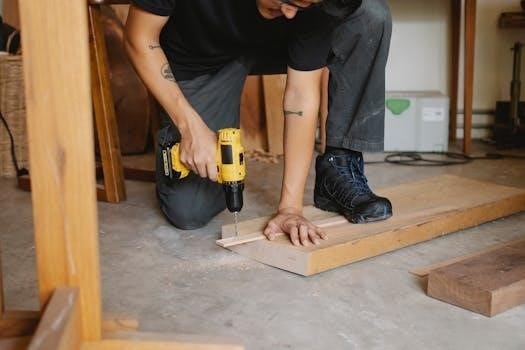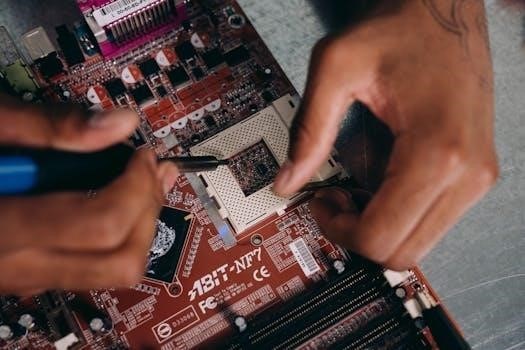
This manual offers comprehensive guidance for the safe and effective installation of the RIBU1C pilot relay. It includes vital details for optimal functionality. From initial mounting to final wiring, this guide provides step-by-step instructions. These instructions ensure a smooth and reliable setup process. Safety precautions are highlighted for user protection.
Overview of the RIBU1C Relay
The Functional Devices RIBU1C stands out as a versatile pilot relay, ideal for diverse applications. Its dual coil voltage capability, accepting either 10-30 VAC/DC or 120 VAC, enhances adaptability. This adaptability makes it suitable for various control systems. Designed for reliability, the RIBU1C boasts a robust 10 Amp SPDT contact rating. This robust design allows it to manage a wide array of tasks, from alarm systems to industrial automation. The pre-packaged design saves time and expense, eliminating the need for separate components like sockets and housings.
The RIBU1C’s enclosed housing is UL accepted for use in plenums and is NEMA 1 rated. This provides enhanced protection in different environments. Its compact design ensures it’s always readily available for diverse projects. The relay features an LED indicator, signaling when the relay is active, facilitating easy monitoring. This relay helps to drive power relays, contactors, and sense voltage being fed to electrical loads.
Its ease of installation and robust design make it a staple for contractors. The RIBU1C is perfect for HVAC control and other applications. It ensures reliable performance in demanding environments.

Key Features and Specifications
The RIBU1C pilot relay is packed with features that make it a versatile choice for various applications. It has a single SPDT continuous duty coil, ensuring reliable operation. The relay’s expected mechanical life is a minimum of 10 million cycles, promising longevity. It operates efficiently within a temperature range of -30 to 140 degrees Fahrenheit. Its humidity range spans from 5 to 95% non-condensing, allowing for use in diverse settings. The relay has a operate time of 20ms and the relay status is shown via an LED that lights when activated.
The dimensions are 1.70 x 2.80 x 1.50 inches, featuring a 0.50 NPT nipple for easy installation. It uses 16 AWG wires rated for 600V. The RIBU1C holds approvals from UL, C-UL, California State Fire Marshal, CE, and RoHS, ensuring safety and compliance. Its housing is UL accepted for plenum use and is NEMA 1 rated.
The relay has a 10 amp contact rating and can be powered by 12 VAC, 24 VDC, or 120 VAC. It has an LED feature and supports surface mounting and has a pilot hub type. These specifications collectively affirm the RIBU1C’s reliability and adaptability across a broad range of control applications.
Wiring Diagram and Connections
Proper wiring is crucial for the RIBU1C to function correctly and safely. Before commencing any wiring, always disconnect power to prevent electrical shock. Consult the detailed wiring diagram included with the relay. This diagram clearly illustrates the connections for both the coil and the SPDT contacts. The RIBU1C supports a flexible coil voltage, accepting either 10-30 VAC/DC or 120 VAC. Ensure the correct voltage is applied to the designated coil terminals.
For the SPDT contacts, identify the common, normally open (NO), and normally closed (NC) terminals. The wiring diagram will indicate which terminal corresponds to each function. Use appropriately sized wires, ideally 16 AWG, rated for at least 600V, to handle the current load safely. Securely fasten all wire connections using wire nuts or other approved connectors.
Double-check all connections against the wiring diagram. Make sure that no bare wires are exposed and that all connections are tight. Incorrect wiring can damage the relay or connected equipment. It could also pose a safety hazard. After wiring, carefully reapply power and test the relay’s operation.
Installation Steps⁚ Mounting the Relay
The RIBU1C relay is designed for easy and secure mounting in a variety of applications. Before beginning the installation, select a suitable location that is accessible for wiring and maintenance. The location should be dry and free from excessive vibration or extreme temperatures. The RIBU1C’s NEMA 1 housing provides protection against basic environmental factors. However, avoid direct exposure to water or harsh chemicals.
The relay can be mounted using the integrated ;50 NPT nipple. This allows for secure attachment to an electrical box or enclosure through a knockout. Remove a knockout from the enclosure, insert the nipple through the hole, and tighten the locknut to secure the relay. Ensure the relay is firmly mounted and does not wobble. This secure mounting prevents stress on the wiring connections.
Alternatively, the relay can be mounted using screws through the housing. Use appropriate screws for the mounting surface, such as sheet metal screws for metal enclosures or wood screws for wooden surfaces. Ensure the screws are tightened adequately, but avoid over-tightening. Over-tightening can damage the housing. Following these steps will ensure a stable and reliable installation;
Connecting to Power Supply (10-30 VAC/DC or 120 VAC)
The RIBU1C relay offers versatile power supply options, accepting either 10-30 VAC/DC or 120 VAC. It is crucial to select the correct voltage to avoid damaging the relay. Always verify the available voltage source before making any connections.
For 10-30 VAC/DC connections, identify the appropriate terminals on the relay. Connect the positive (+) wire of the power supply to the designated positive terminal. Then connect the negative (-) or common wire to the negative terminal. Ensure the wiring is secure and properly insulated. Use wire connectors or solder to prevent loose connections.
For 120 VAC connections, connect the hot (line) wire to the designated terminal on the relay. Connect the neutral wire to the appropriate neutral terminal. Again, verify that all connections are secure and well-insulated. Using wire nuts is a common practice for these connections.
Before applying power, double-check all wiring to ensure accuracy. Incorrect wiring can damage the relay or create a safety hazard. Once you’ve verified the connections, cautiously apply power and observe the relay’s operation. The LED indicator should light up when the relay is activated.

Wiring the SPDT Contacts
The RIBU1C relay features SPDT (Single Pole Double Throw) contacts, providing flexibility in controlling circuits. These contacts consist of a common terminal, a normally open (NO) terminal, and a normally closed (NC) terminal. Understanding how to wire these contacts is essential for proper operation.
The common terminal serves as the central connection point for the relay. The normally open (NO) terminal is disconnected from the common terminal when the relay is not energized. When the relay is energized, the NO terminal connects to the common terminal, closing the circuit.
Conversely, the normally closed (NC) terminal is connected to the common terminal when the relay is not energized. When the relay is energized, the NC terminal disconnects from the common terminal, opening the circuit.
To wire the SPDT contacts, first identify the specific function you want to achieve. If you need a circuit to close when the relay is activated, connect your device between the common and NO terminals. If you need a circuit to open when the relay is activated, connect your device between the common and NC terminals.
Ensure all wiring is secure and insulated. Use appropriately sized wire connectors for reliable connections. Double-check your wiring before applying power to avoid any issues.
Common Applications⁚ HVAC Control
The RIBU1C relay finds extensive use in HVAC (Heating, Ventilation, and Air Conditioning) systems due to its versatility and reliability. Its ability to switch between circuits makes it ideal for various control functions within HVAC applications. One common application is controlling blower fans. The RIBU1C can be wired to activate a blower fan based on a thermostat signal. This allows the fan to run only when heating or cooling is required, saving energy.
Another application is controlling dampers. Dampers regulate airflow within ductwork, and the RIBU1C can be used to open or close them based on system demands. This can optimize airflow for different zones or to isolate sections of the system.
The RIBU1C is also used in controlling pumps. For example, it can activate a pump to circulate water in a hydronic heating system. The relay responds to thermostat calls, ensuring that the pump runs only when heat is needed.
Furthermore, the RIBU1C can be implemented in zone control systems. These systems allow for independent temperature control in different areas of a building. The RIBU1C relay switches heating or cooling based on individual zone thermostat settings. Its compact size and easy installation make it a practical choice for HVAC professionals.

Troubleshooting Common Issues
When troubleshooting the RIBU1C relay, several common issues may arise. One frequent problem is the relay failing to activate. This can stem from an incorrect power supply, so verify the voltage matches the relay’s specifications (10-30 VAC/DC or 120 VAC). Ensure the wiring connections are secure and properly connected according to the wiring diagram.
Another issue is the relay chattering or rapidly switching on and off. This often indicates a fluctuating or unstable voltage supply. Check the power source for any voltage drops or surges. Also, inspect the wiring for loose connections or damage.
If the relay activates but the connected device doesn’t function, the problem may lie with the load side of the circuit. Confirm that the load is within the relay’s contact rating (10 Amp SPDT). Verify the wiring connections to the load and ensure the device itself is operational.
Another potential issue is the LED indicator not illuminating when the relay is activated. This could indicate a faulty LED or a problem with the coil circuit; Use a multimeter to test the coil for continuity and proper voltage.
Overheating can also be a sign of a problem. If the relay is hot to the touch, it might be overloaded or have internal damage. Immediately disconnect the power and replace the relay.
Safety Precautions
Prior to installing or servicing the RIBU1C relay, always disconnect the power supply to prevent electrical shock. Verify that the circuit is de-energized using a reliable voltage tester. Never work on live circuits.
Wear appropriate personal protective equipment (PPE), including safety glasses and insulated gloves. This reduces the risk of injury from electrical hazards or sharp edges.
Ensure the RIBU1C relay is installed in a dry, well-ventilated location. Avoid exposure to moisture, corrosive substances, and extreme temperatures. These conditions can damage the relay and compromise its performance.
When wiring the relay, use appropriately sized and rated wires. Follow the wiring diagram carefully, ensuring all connections are secure and properly insulated. Loose or improperly insulated connections can cause short circuits or electrical fires.
Do not exceed the relay’s specified voltage and current ratings. Overloading the relay can lead to overheating, damage, and potential fire hazards.
Inspect the relay regularly for signs of wear, damage, or corrosion. Replace any damaged relays immediately to prevent malfunctions and ensure safety.
If you are not qualified to work with electrical equipment, consult a licensed electrician for installation and maintenance. Improper installation can be dangerous and may void the warranty.
Maintenance and Expected Relay Life
To ensure the longevity and reliable operation of your RIBU1C relay, regular maintenance is essential. Periodically inspect the relay for any signs of physical damage, such as cracks, corrosion, or loose connections. Clean the relay with a dry cloth to remove dust and debris, avoiding the use of solvents or harsh chemicals.
Check the wiring connections to ensure they are secure and properly insulated. Tighten any loose screws or terminals to prevent arcing or overheating. Verify that the relay is operating within its specified voltage and current ratings.
The expected mechanical life of the RIBU1C relay is a minimum of 10 million cycles. However, the actual lifespan can vary depending on the operating conditions and the load being switched. Factors such as high inrush currents, frequent switching, and exposure to extreme temperatures can reduce the relay’s lifespan.
Monitor the relay’s performance for any signs of degradation, such as slow response times, erratic behavior, or failure to switch. If you observe any of these issues, replace the relay immediately to prevent system malfunctions.
Keep a record of all maintenance activities, including inspection dates, cleaning procedures, and any repairs or replacements made. This documentation will help you track the relay’s performance and identify any potential problems early on.
